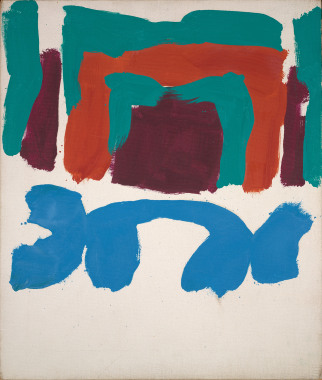
Taking his inspiration primarily from Henri Matisse and Jazz music, Ray Parker was associated with several Abstract movements including Post-Painterly Abstraction, Color Field Painting, Abstract Expressionism, and the New York School. He was born in South Dakota in 1922, and attended the University of Iowa, Iowa City, where he later earned his MFA. During his schooling in the 1940s, Parker’s work was influenced primarily by Cubism, but into the 1950s, when he was living in New York, he befriended prominent Abstract Expressionists Mark Rothko and Willem de Kooning, among others, who would have a formative influence on his career. Informed by jazz, his style became improvised and as a result, comes across as a radically imprecise practice that serves as a counterpoint to earlier Abstract schools whose philosophies often centered on geometry or were quasi-figurative.
He was an ardent proponent of Color Field painting, which he referred to as “intent” painting and spoke to assert the subtle differences between this and other movements under the Abstract Expressionist umbrella, namely gesture painting. The difference, he said, lay in a heavily intellectual consideration of the trajectory of art and its own place within that landscape: “’Clarity in painting depends on knowing other (past) art well enough that it can’t reappear even in the cleverest disguise to allow confusion.’” He defined both intent and gesture painting as a philosophical commitment to originality, but distinguished intent painting thusly: “’having once achieved an original form that fulfills his intention, he regards as trivial the attempts to say something in a new way.’” While gesture painters, like Jackson Pollack, seek to be entirely original each time they approach a new canvas, Color Field painters are stylistically consistent and repeat a single format.
Parker is perhaps best known for his series, Simple Paintings, works produced during the late 1950s and early 1960s that are characterized by their intense colors, applied in soft rounded shapes on a white background. This work from 1963, Untitled falls within this small window and serves as a unique example of this format, presenting an improvised, simplistic composition made up of soft shapes against a white background. The color story is perhaps the only aspect of this work that appears carefully considered, drawing the eye and leading us to notice the repetition and variation of forms.
Parker was an influential teacher as well as artist in his own right and taught painting for a number of years at the University of Minnesota and Hunter College. In the late 1950s, he was represented by the Samuel Kootz Gallery, an important Contemporary gallery whose artist clients included Picasso, Hans Hofmann, and all the major players of the Abstract Expressionist vanguard. His work is housed in major collections including the Tate Modern, the Museum of Modern Art, the Metropolitan Museum of Art, and the Solomon R. Guggenheim Museum.
